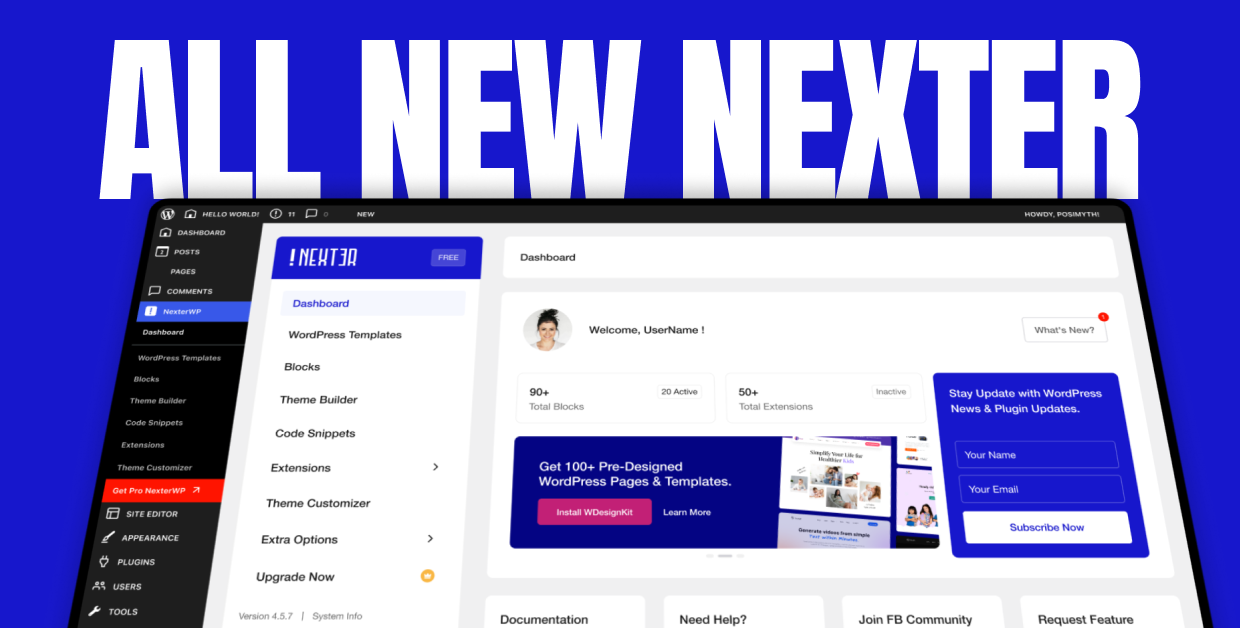Ever wondered what the difference between a theme and a template in WordPress is? We’ve got the answers you need to build a stunning website.
While “theme” and “template” are often used interchangeably in WordPress, grasping their distinct roles is crucial for design control. Both influence your website’s look, but their scope differs significantly.
A theme sets the overall design foundation, while templates customize individual pages within that framework.
Misunderstanding this can hinder your ability to fully personalize your website and limit your creative control, leaving you with a default design instead of a truly unique online presence.
In this article, we break down the pros and cons of theme and template as well as the key differences between template vs theme.
What is a WordPress Theme?
A WordPress theme is a collection of files that dictate the overall look and feel of your website.
These theme files include templates, stylesheets, images, and JavaScript, all working together to control aspects like layout, typography, color schemes, and widget placements.
Essentially, the theme is the skin of your site, and it defines how your content is presented to visitors.
You can only activate one theme at a time on your website, but you’re free to change it whenever you like. This flexibility allows you to refresh your site’s appearance without altering the core content.
Whether you opt for one of the default themes provided by WordPress or invest in a premium theme, there’s a vast selection available in the theme directory to suit your needs.
Pros and Cons of Using Themes in WordPress
Pros of Using Themes in WordPress
- Vast Selection of Styles: With thousands of themes available, you have a wide array of designs to choose from. Whether you’re building a blog, an online store, or a portfolio, there’s a theme that fits your vision.
- Complete Design Control: Themes give you control over your site’s entire design. You can customize headers, footers, sidebars, and more to create a cohesive look.
- User-Friendly Customization: Many themes offer intuitive customization panels, allowing you to personalize your site without any coding knowledge.
Cons of Using Themes in WordPress
- Limited Flexibility Without Coding: While themes are customizable, you might find limitations if you want to make significant changes without knowing how to code.
- Potential Compatibility Issues: Some themes may not function well with certain plugins or might not be updated regularly. This leads to security risks or functionality problems.
- Can Be Resource-Heavy: Feature-rich themes might slow down your website, affecting load times and user experience.
Looking for the best themes on WordPress? Here are the 20 best WordPress themes you can consider.
What is a WordPress Template?
A WordPress template is a specific file within a theme that controls the layout of a particular page or group of pages on your website.
While themes govern the overall design, templates allow you to customize individual sections. They give you more specific control over how certain pages display content, enabling unique layouts and functionalities for different parts of your site.
Templates are especially useful when you want a page to stand out or serve a specific purpose. You may use standard templates, customize existing ones, or incorporate additional features.
Pros and Cons of Using Templates in WordPress
Pros of Using Templates in WordPress
- Unique Layouts for Specific Pages: Templates let you design distinctive layouts for particular pages, making your site more dynamic and engaging.
- Adaptable for Different Content Types: You can customize how various types of content are displayed, improving readability and overall user experience.
- Enhanced Site Structure: Using templates can help you organize your site more effectively, guiding visitors through your content in a logical way.
Cons of Using Templates in WordPress
- Limited by Theme Settings: Your ability to customize templates might be restricted by the theme you’re using, which can limit your creative control.
- May Require Technical Knowledge: Creating or modifying templates often involves working with code like PHP, HTML, and CSS.
- Risk of Inconsistency: If not managed carefully, using multiple templates can lead to a disjointed look across your site, potentially confusing visitors.
Looking for the right theme for your website? Here are the 20 Best WordPress Themes to choose from.
Difference Between Theme and Template in WordPress: Key Differences
The key difference between WordPress theme vs. template boils down to this: themes provide the overall design for your entire website, while templates dictate the layout of specific pages or sections within that design.
Let’s take a closer look at the major differences:
1. Scope
A theme encompasses your entire website. It’s the foundation that determines the overall look and feel, including things like color palettes, typography, and the general layout of your site.
Templates, on the other hand, have a much narrower focus. They control the structure of individual pages or sections, such as a single blog post, a page with a contact form, or your archive page that lists all your posts.
2. Function
Themes provide the overall design and functionality of your website. They set the stage for how your content is presented and how users interact with your site.
Templates determine how the content is arranged on specific pages. They tell WordPress where to place elements like the header, footer, sidebar, and the content itself.
3. Features
Themes often come with a wide range of features, including template files, stylesheets (CSS), JavaScript files, customizer options, widgets, and menus. These features work together to create the overall user experience.
While templates are a part of a theme’s features, they specifically focus on the structure and layout of individual pages.
Every WordPress theme contains a collection of templates. When someone visits a specific page on your website, WordPress uses the corresponding template file to display the content.
For example, if someone visits a single blog post, WordPress will use the single.php template file.
You can customize your website by choosing a theme that aligns with your vision and then modifying the existing templates or even creating new ones to achieve unique layouts.
This flexibility allows you to have complete control over the look and feel of your website.
Nexter WordPress Theme offers you highly customizable multi-purpose themes with features such as global containers, fonts, colors, and numerous other personalization options.
With Nexter Theme, you can choose from multi-purpose WordPress themes with the fastest loading times and No JQuery dependency so that you can have a website that looks good without any performance issues.
Nexter Theme also gives you access to over 1000 pre-built website custom templates for customizing every aspect of your website to suit your unique brand identity.
Need a theme that meets all your needs? Here are the 6 best WordPress multipurpose themes.
Stay updated with Helpful WordPress Tips, Insider Insights, and Exclusive Updates – Subscribe now to keep up with Everything Happening on WordPress!
Wrapping Up
Understanding the difference between WordPress theme vs template gives you more control over the design of your website and to fully customize it based on your brand needs.
If you are looking for a plugin compatible with all popular WordPress themes and templates, consider using Nexter Blocks, a Gutenberg plugin with more than 90 blocks to help you fully customize your website’s design with advanced features.
Along with Nexter Blocks, you also get the Nexter Theme that allows you to build your website from the ground up in just a few hours. It offers you unlimited personalization choices to ensure your website has a unique presence and offers its visitors a pleasant experience.
For a good-looking and highly functional website, explore the 90+ Gutenberg blocks offered by Nexter Blocks today!
FAQs on Theme vs Template WordPress
Can I use multiple templates within a single WordPress theme?
Yes, you can use multiple templates within a WordPress theme, and it is very common. Using multiple templates allows you to have more visual variety on your website, as each page can be tailored with a different layout. You can also incorporate content-specific designs using multiple templates.
What is the main difference between a WordPress theme and a template?
The core difference between theme and template in WordPress is in their scope. A theme governs the overall design of the entire website, like a master blueprint. In contrast, a template controls the layout of individual pages or sections within that theme, offering customized designs for specific types of content.
Do I need coding skills to use themes and templates in WordPress?
No, coding is not an essential skill for using WordPress themes and templates. You can easily install, activate, and customize theme designs as many themes offer user-friendly options to change colors, fonts, and layouts without writing any code. However, coding knowledge can help you use more advanced customization options for your needs.
Can I switch themes without losing my templates?
Switching WordPress active themes generally doesn’t delete your templates, as they are separate files. However, compatibility issues may arise, which would then require adjustments to ensure proper display. If you face issues, backup your website and check the new theme’s documentation for guidance on template handling and potential migration needs.
Is it possible to use a theme without any templates?
You cannot use a theme without a template. Themes are built on templates, as they provide the structure, layout, and styling for different types of content, like pages, posts, and archives. While you can use a theme without adding extra templates, every theme comes with a set of default templates.











